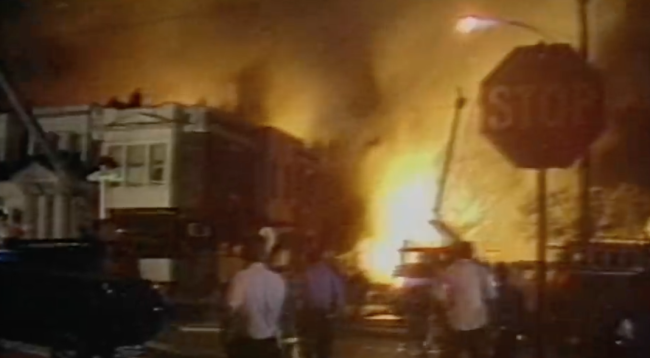You have /5 articles left.
Sign up for a free account or log in.

The MOVE town house burns in Philadelphia in 1985.
YouTube
The University of Pennsylvania and Princeton University are facing serious questions about how researchers handled human remains from the 1985 police bombing of a Black separatist group in West Philadelphia. This scrutiny follows revelations that the universities housed unidentified children’s remains from the bombing for years, and that the remains were used for teaching at Penn.
The anthropologist at the center of the case says he’s troubled by allegations that he acted unethically, and some in the field have spoken up to defend him. But critics see the case as an undeniable example of academic racism, made even more bitter by the police actions that underlie it.
Looking for Answers
In 1985, Philadelphia police moved in on the headquarters of the separatist group, known as MOVE. After a standoff, police bombed the town house via helicopter, killing six adult MOVE members and five of their children.
The bombing, which subsequently burned more than 60 surrounding homes, was widely criticized. Survivors of the group later sued the city, winning $1.5 million. Former neighbors won millions more in a separate case against Philadelphia.
In November 2020, the Philadelphia City Council voted to formally apologize for the bombing.
Then, this week, WHYY's Billy Penn published a story saying that human remains from the bombing, believed to be those of two children, sat in a cardboard box on a shelf at Penn’s Pennsylvania Museum of Archaeology and Anthropology for years. Originally, they’d been entrusted to a Penn anthropologist, Alan Mann, so that he could verify their identities. Yet decades later, apparently because Mann was unable to conclusively identify them, they had had not been returned to family members.
Mann took a job at Princeton in 2001 and brought the remains with him. Janet Monge, Mann’s former student, reportedly reanalyzed the bones from 2016 to 2019 during her time as curator of the Penn Museum’s physical anthropology section. She also reportedly used them to teach an online course on forensic anthropology. But by 2019, Mann had retired and Monge left Penn, making the remains’ exact whereabouts a mystery.
The Philadelphia Inquirer subsequently reported that the remains had been transferred from the Penn museum back to Mann about a week ago.
Overlapping ‘Violence’
A separate op-ed in the Inquirer by writer and activist Abdul-Aliy Muhammad said that the “state violence against Black Philadelphians represented by the MOVE bombing, which City Council apologized for last November, overlaps with the violence of academic institutions keeping the remains of Black people rather than relinquishing those remains for burial.”
Anthropologists and other academics expressed concern, disgust or both at the descriptions of apparent neglect, especially in light of recent killings of Black youth by police. Ruha Benjamin, professor of African American studies at Princeton, tweeted, for instance, “IT’S TOO MUCH. 24hrs after the murder of 16yr old Ma'Khia Bryant, we learn that researchers at Penn & Princeton were storing & studying the remains of Black teens killed in the MOVE bombing?!?!”
The news cast a particular pall over Penn, which just this month apologized for what it called the “unethical possession of human remains” in the Samuel G. Morton Cranial Collection. In the 1800s, Morton collected skulls from around the world, often from unmarked graves, to try to prove his racist beliefs about cranial size and shape being linked to race and intelligence. A formal report on what to do with the collection recommended returning the skulls to their descendants and communities of origin wherever possible. Among other changes, it also recommended that the museum create a visitation location for human remains to provide a "quiet, contemplative space for reconnections and consultation visits in its future plans for rehousing the collections."
The Morton Collection report made no mention of the museum’s newer remains, which originated from within the city of Philadelphia.
A spokesperson for the Penn Museum said that the university has been able to confirm that Mann, acting as an independent forensic anthropologist, agreed in 1985 to conduct an examination of a partial set of human remains from the bombing. Contradicting the Billy Penn report mentioning two children, the spokesperson said the remains were two bones from one individual person.
Because of the inconclusive evidence on identity, the spokesperson said, the Philadelphia medical examiner’s office transferred the remains to Mann’s custody for continued analysis, and he took the remains with him to Princeton.
With new technology available in the Penn Museum’s lab, Monge began to investigate them again in 2016, according to the museum. The bones still haven’t been identified, however; without providing details, the spokesperson said that forensic anthropologists have asked the deceased’s presumed family members to conduct a DNA analysis but were not unable to proceed.
Following the Morton Collection report guidelines, the spokesperson said, “we will be reassessing our practices of collecting, stewarding, displaying and researching human remains.”
The Philadelphia Department of Public Health told Billy Penn that the city office only releases individuals’ remains to their next of kin, and when that's not possible, the remains are cremated.
Mann said via email that he was “sorry to learn that there is a perception that what I did with the MOVE human remains was wrong.” He said he had "very little to do with the events that resulted in the deaths of so many innocent people, nor with the subsequent events after the destruction of the MOVE house.”
Princeton did not provide immediate comment on the case.
According to the Inquirer, Mann disagreed with another well-known anthropologist, Ali Hameli, who believed the remains were those of 14-year-old Katricia Dotson, known to MOVE members as Tree Africa. But Mann reportedly believed the remains were those of a young adult woman -- meaning that there could have been another victim in the bombing.
A surviving member of the Africa family, Mike Africa Jr., told Billy Penn that he was disturbed to see video footage of Monge apparently using the bones for teaching. Of Tree, he said, “She would run, scour the park, for the biggest tree. The biggest tree. So she could climb it. And no one, no one could climb higher than she could. She didn’t have any fear about the height. It seemed like the higher she went, the more comfortable she was. She never feared the way up.”
‘Do No Harm’
Carolyn Rouse, Mann’s former colleague, has publicly defended him, telling the Inquirer that the case was a problem to be solved, not a controversy.
“There’s no racism. This was a forensic investigation and nobody came to claim the remains,” she said. Moreover, Mann and Monge “were traumatized by working on the case. They were advocates for these people, and they were horrified by what the city did.”
Others disagree. Kathleen Brown, a professor of history at Penn who has advised the student-led Penn & Slavery Project, said that she didn’t have any special knowledge of the case but was “shocked and sickened to learn that the victim's remains had been at the Penn Museum and used for teaching.”
Brown said that the student-led research at Penn in which she was involved highlighted Penn Museum's holdings of human remains -- and that this helped spark change regarding the Morton collection. Yet “none of us had any idea that a murdered child's remains were also in the museum and being treated so disrespectfully.”
Recent Penn graduate Malkia Okech said she spent four years a working as a collections assistant at the Penn Museum and knew Monge, but that she did not know about the MOVE bombing victim’s remains until this week. Upon hearing about how they’d been stored and handled, Okech said, “I was upset, hurt, betrayed and traumatized as one of the few Black students who had a regular presence in the building.”
The museum is sometimes referred to as a cemetery, and its supposed hauntedness is lauded as “quirky,” Okech said. Yet underneath those jokes is the ugly truth that the museum “has normalized human remains and death in a way that benefits the ivory tower at the expense of Black Philadelphians.”
The American Anthropological Association doesn’t have special professional guidelines about the treatment of human remains. Its Principles of Professional Responsibility do say that a “a primary ethical obligation shared by anthropologists is to do no harm.”
Among the most serious harms that anthropologists should seek to avoid are “harm to dignity, and to bodily and material well-being, especially when research is conducted among vulnerable populations. Anthropologists should not only avoid causing direct and immediate harm but also should weigh carefully the potential consequences and inadvertent impacts of their work."
Many anthropologists are paying more attention to concept of repatriation -- the return of people and things to their place of origin -- as they work to decolonize the field.
Benjamin, at Princeton, on Twitter said she couldn’t fully process the MOVE bombing remains details quite yet, so instead of analysis she recommended what she called required reading: Gabeba Baderoon’s article “Baartman and the Private: How Can We Look at a Figure That Has Been Looked at Too Much.”
Jamie Clark, an assistant professor of archaeology at George Mason University, said she talks about repatriation in her unit on ethics. One of the key concepts is the Native American Graves Protection and Repatriation Act. But Clark said she’s used the recent stories about Penn remains “to show that these issues aren’t just limited the handling of Native American individuals," and that they impact other minoritized populations, as well. Yet as the act specifically applies to Indigenous remains, she said, “these other collections fall between the gaps.”
“There’s been no nationwide movement to catalog and repatriate the collections,” Clark said -- at least not yet.
“I think it’s important for students to be aware of the problematic aspects of the discipline,” she continued, “and to realize that the field still has a long way to go.”
Mann said he plans to take the remains -- the upper end of a thigh bone and a small part of one pelvic bone -- to the Philadelphia medical examiner within the next few days.





